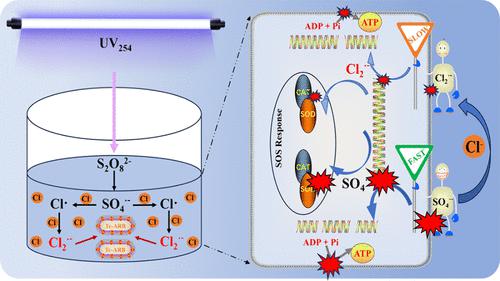当前位置:
X-MOL 学术
›
Environ. Sci. Technol.
›
论文详情
Our official English website, www.x-mol.net, welcomes your feedback! (Note: you will need to create a separate account there.)
Evaluating the Impact of Cl2•– Generation on Antibiotic-Resistance Contamination Removal via UV/Peroxydisulfate
Environmental Science & Technology ( IF 11.4 ) Pub Date : 2024-03-13 , DOI: 10.1021/acs.est.3c09952 Hao Yang 1 , Dongyang He 1 , Linyi Fan 1 , Fangyuan Cheng 1 , Yangjian Zhou 2 , Yu Lei 3 , Ya-nan Zhang 1 , Xin Yang 2 , Jiao Qu 1
Environmental Science & Technology ( IF 11.4 ) Pub Date : 2024-03-13 , DOI: 10.1021/acs.est.3c09952 Hao Yang 1 , Dongyang He 1 , Linyi Fan 1 , Fangyuan Cheng 1 , Yangjian Zhou 2 , Yu Lei 3 , Ya-nan Zhang 1 , Xin Yang 2 , Jiao Qu 1
Affiliation

|
The removal of antibiotic-resistant bacteria (ARB) and antibiotic-resistance genes (ARGs) using sulfate anion radical (SO4•–)-based advanced oxidation processes has gained considerable attention recently. However, immense uncertainties persist in technology transfer. Particularly, the impact of dichlorine radical (Cl2•–) generation during SO4•–-mediated disinfection on ARB/ARGs removal remains unclear, despite the Cl2•– concentration reaching levels notably higher than those of SO4•– in certain SO4•–-based procedures applied to secondary effluents, hospital wastewaters, and marine waters. The experimental results of this study reveal a detrimental effect on the disinfection efficiency of tetracycline-resistant Escherichia coli (Tc-ARB) during SO4•–-mediated treatment owing to Cl2•– generation. Through a comparative investigation of the distinct inactivation mechanisms of Tc-ARB in the Cl2•–- and SO4•–-mediated disinfection processes, encompassing various perspectives, we confirm that Cl2•– is less effective in inducing cellular structural damage, perturbing cellular metabolic activity, disrupting antioxidant enzyme system, damaging genetic material, and inducing the viable but nonculturable state. Consequently, this diminishes the disinfection efficiency of SO4•–-mediated treatment owing to Cl2•– generation. Importantly, the results indicate that Cl2•– generation increases the potential risk associated with the dark reactivation of Tc-ARB and the vertical gene transfer process of tetracycline-resistant genes following SO4•–-mediated disinfection. This study underscores the undesired role of Cl2•– for ARB/ARGs removal during the SO4•–-mediated disinfection process.
中文翻译:

评估 Cl2•– 生成对通过紫外线/过二硫酸盐去除抗生素耐药性污染的影响
使用基于硫酸根阴离子自由基(SO 4 •–)的高级氧化工艺去除抗生素抗性细菌(ARB)和抗生素抗性基因(ARG)最近引起了相当大的关注。然而,技术转让仍然存在巨大的不确定性。特别是,尽管在某些情况下,Cl 2 •–浓度明显高于SO 4 •– 浓度,但 SO 4 •– 介导的消毒过程中产生的二氯自由基 (Cl 2 •– )对ARB / ARG 去除的影响仍不清楚。基于SO 4 •–的程序适用于二级污水、医院废水和海水。本研究的实验结果表明,在SO 4 •–介导的处理过程中,由于Cl 2 •–的产生,对四环素耐药大肠杆菌(Tc-ARB)的消毒效率产生不利影响。通过对 Cl 2 •– - 和 SO 4 •–介导的消毒过程中 Tc-ARB 的不同失活机制进行比较研究,涵盖各种角度,我们确认 Cl 2 •–在诱导细胞结构损伤方面效果较差,扰乱细胞代谢活动,破坏抗氧化酶系统,破坏遗传物质,并诱导可行但不可培养的状态。因此,由于Cl 2 •–的产生,这降低了SO 4 •–介导的处理的消毒效率。重要的是,结果表明Cl 2 •–的产生增加了与Tc-ARB 暗再激活和SO 4 •–介导的消毒后四环素抗性基因的垂直基因转移过程相关的潜在风险。这项研究强调了在SO 4 •–介导的消毒过程中Cl 2 •–对于去除ARB/ARG的不良作用。
更新日期:2024-03-13
中文翻译:

评估 Cl2•– 生成对通过紫外线/过二硫酸盐去除抗生素耐药性污染的影响
使用基于硫酸根阴离子自由基(SO 4 •–)的高级氧化工艺去除抗生素抗性细菌(ARB)和抗生素抗性基因(ARG)最近引起了相当大的关注。然而,技术转让仍然存在巨大的不确定性。特别是,尽管在某些情况下,Cl 2 •–浓度明显高于SO 4 •– 浓度,但 SO 4 •– 介导的消毒过程中产生的二氯自由基 (Cl 2 •– )对ARB / ARG 去除的影响仍不清楚。基于SO 4 •–的程序适用于二级污水、医院废水和海水。本研究的实验结果表明,在SO 4 •–介导的处理过程中,由于Cl 2 •–的产生,对四环素耐药大肠杆菌(Tc-ARB)的消毒效率产生不利影响。通过对 Cl 2 •– - 和 SO 4 •–介导的消毒过程中 Tc-ARB 的不同失活机制进行比较研究,涵盖各种角度,我们确认 Cl 2 •–在诱导细胞结构损伤方面效果较差,扰乱细胞代谢活动,破坏抗氧化酶系统,破坏遗传物质,并诱导可行但不可培养的状态。因此,由于Cl 2 •–的产生,这降低了SO 4 •–介导的处理的消毒效率。重要的是,结果表明Cl 2 •–的产生增加了与Tc-ARB 暗再激活和SO 4 •–介导的消毒后四环素抗性基因的垂直基因转移过程相关的潜在风险。这项研究强调了在SO 4 •–介导的消毒过程中Cl 2 •–对于去除ARB/ARG的不良作用。



























 京公网安备 11010802027423号
京公网安备 11010802027423号